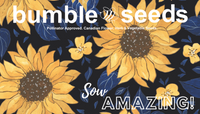Rudbeckia - Brown-Eyed Susan (Rudbeckia triloba) Non-GMO - Organically Grown - Flower
Rudbeckia - Brown-Eyed Susan (Rudbeckia triloba) Non-GMO - Organically Grown - Flower
Type: Short-Lived Perennial/Biennial
Description:
Rudbeckia triloba, commonly known as Brown-Eyed Susan, is a prolific bloomer that produces masses of small, daisy-like golden-yellow flowers with deep brown centers. This branching, bushy plant creates a stunning display from mid-summer to fall, attracting pollinators such as bees and butterflies. Its airy, natural growth habit makes it an excellent choice for cottage gardens, prairie plantings, and wildflower meadows. Though short-lived, it readily self-seeds, ensuring a continuous presence in the garden.
Cultivation Instructions:
• Soil: Prefers well-draining, fertile soil but tolerates poor or dry soils once established.
• Light: Thrives in full sun but can tolerate partial shade.
• Watering: Moderate water needs; drought-tolerant once established. Water regularly during prolonged dry periods.
• Fertilization: Generally not required, but a light application of compost or a balanced fertilizer in spring can enhance growth.
• Spacing: Space plants 12-18 inches apart to allow good air circulation.
• Maintenance: Deadheading encourages prolonged blooming, but allowing some flowers to set seed will promote self-seeding for future growth. Cut back in late fall or early spring for tidier growth.
Stratification & Germination:
• Germination Temperature: 65-75°F
• Stratification: Cold stratification recommended for improved germination. Mix seeds with moist sand and refrigerate for 30 days before sowing.
• Sowing: Direct sow in fall or early spring after stratification. For indoor sowing, start 6-8 weeks before the last frost date.
• Depth: Sow seeds on the surface of the soil and lightly press in, as they require light to germinate.
• Moisture: Keep soil consistently moist until germination, which typically occurs in 7-21 days.
Seed count: 25
Rudbeckia triloba is a resilient and low-maintenance plant that provides long-lasting color and supports beneficial pollinators, making it a valuable addition to any naturalized or ornamental garden.





